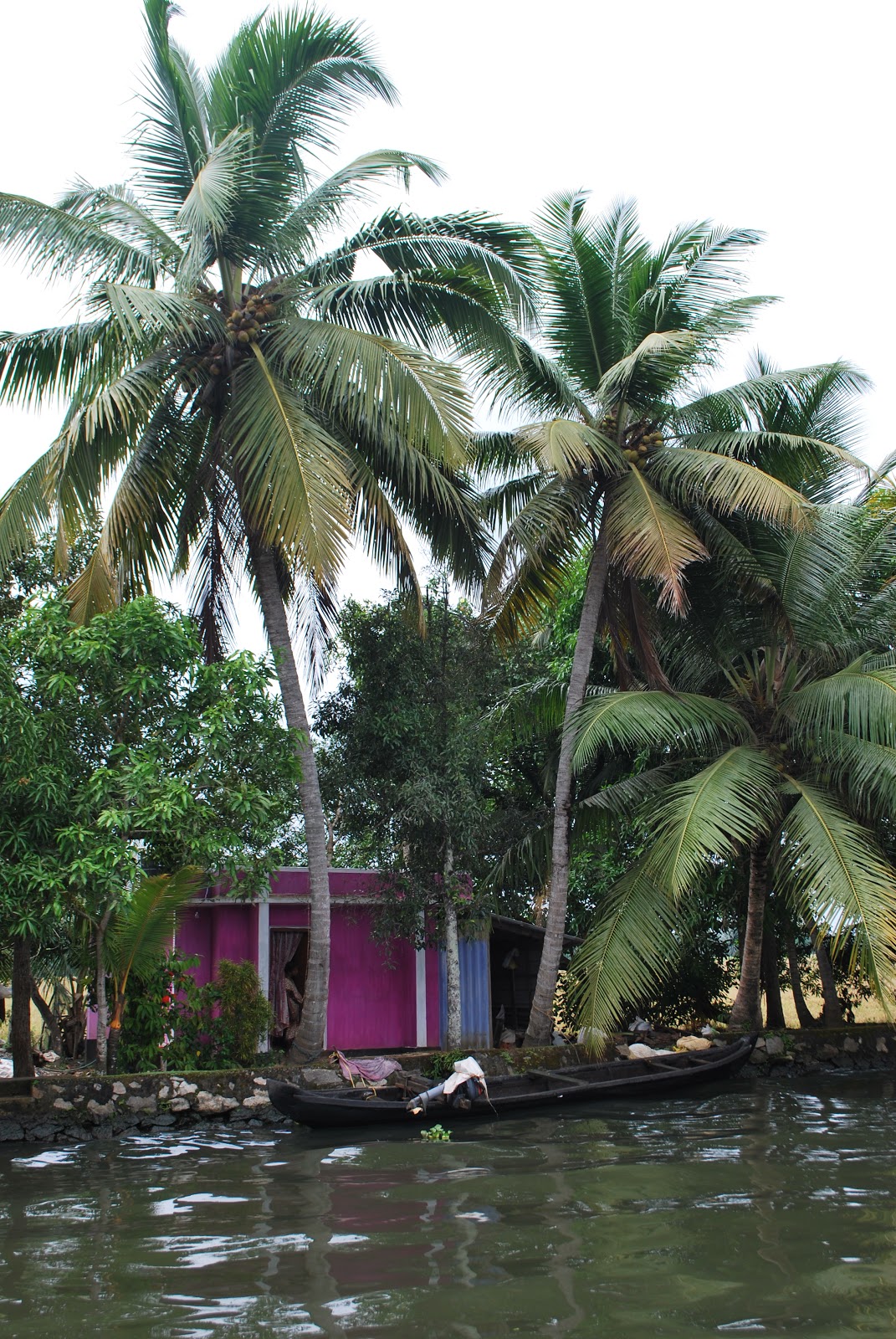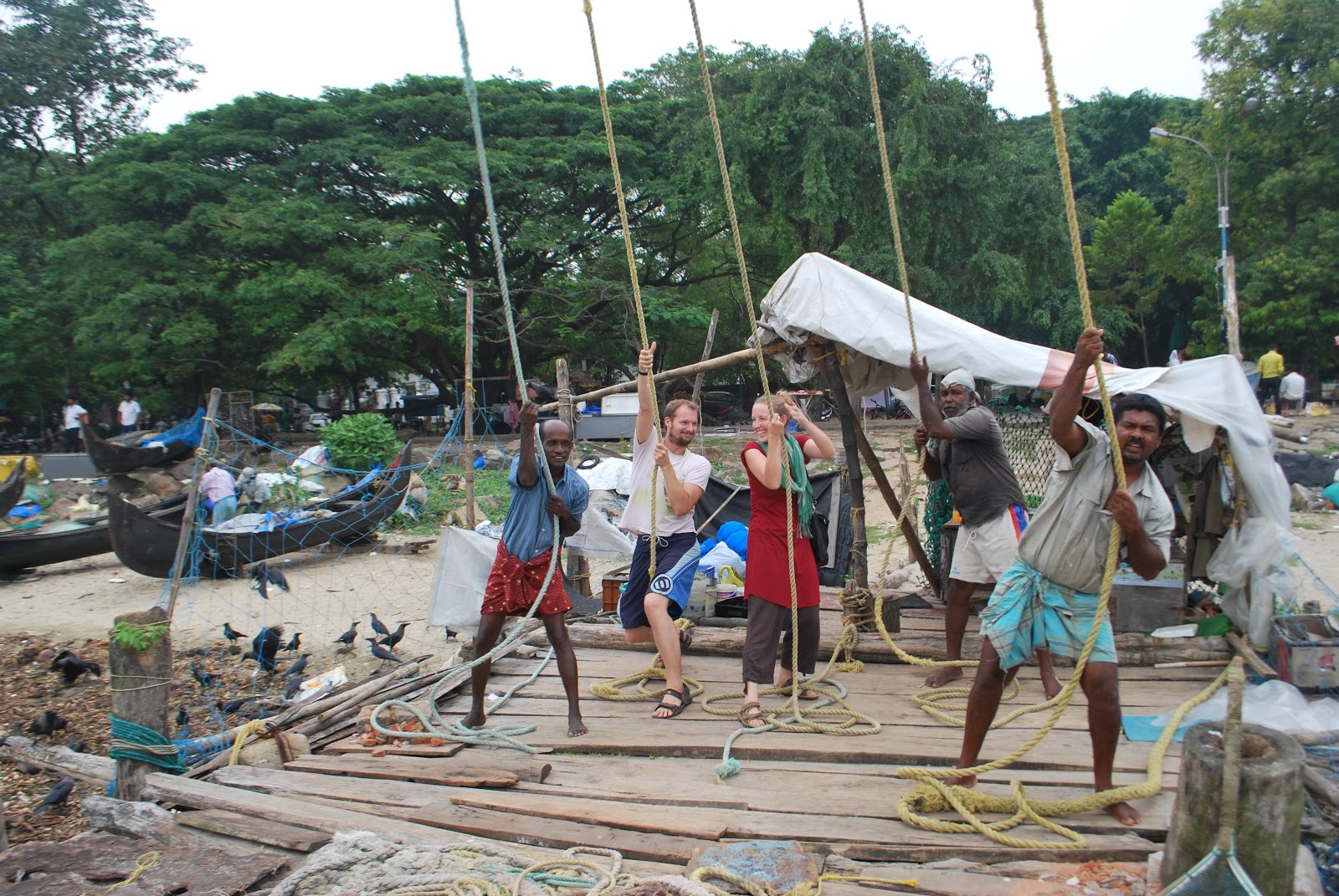 |
| It seemed no-one else would get any of M.'s roadside pineapple |
 Our taxi dropped us at the relaxed Palm Residency cottages out near Finishing Point. Starting point and Finishing point are where Allepey's annual snake boat races are run. Each village crafts a sleek, long, narrow hulled boat and then packs it with its strongest men to paddle madly in a series of races during August. Our plans were much more sedate - a luxurious house boat to slowly ply the backwaters stopping only to offer us massage and the chance to buy prawns. And we took good advantage of both opportunities. The massage was my first Ayurvadic experience and it was certainly an intimate affair. Herbal oils are key to the restorative properties of Ayurveda and any clothing at all is surplus. Even so, the slippery pressure on my perineum and vigorous buttock massage was an eyebrow-raising experience. I could only hope my mother, being massaged at the same time, was also taking everything in her stride. The prawns that we purchased delivered even more. Massive specimens, more akin to lobsters, were waved at us. We took them, and our boat crew cooked them.
Our taxi dropped us at the relaxed Palm Residency cottages out near Finishing Point. Starting point and Finishing point are where Allepey's annual snake boat races are run. Each village crafts a sleek, long, narrow hulled boat and then packs it with its strongest men to paddle madly in a series of races during August. Our plans were much more sedate - a luxurious house boat to slowly ply the backwaters stopping only to offer us massage and the chance to buy prawns. And we took good advantage of both opportunities. The massage was my first Ayurvadic experience and it was certainly an intimate affair. Herbal oils are key to the restorative properties of Ayurveda and any clothing at all is surplus. Even so, the slippery pressure on my perineum and vigorous buttock massage was an eyebrow-raising experience. I could only hope my mother, being massaged at the same time, was also taking everything in her stride. The prawns that we purchased delivered even more. Massive specimens, more akin to lobsters, were waved at us. We took them, and our boat crew cooked them. |
| Giant Prawn |
The food in the south is dramatically different to that of the North (Northern, Mughlai and Punjabi food also being the more familiar to British tastes - rich tomato and cream sauces like the ubiquitous Rogan josh and Kormas). Only the word Vindaloo seems to have traveled from Goan shores - as the British dish bears little relation to its inspiration. But here we were in Kerala, self-proclaimed God's Own Country - and on the cuisine alone it beats that other G.O.C claimant, Yorkshire, into pulpy mush. The rice is fat and attractive, perfect for dressing with sambhar - a thin red sauce that belies it sharp spicy hotness. Thoram, usually made with cooked cabbage, mustard seed and a hint of ginger, is a moreish salad to balance the curry dishes. Here the curries are laden with Kerala's sine qua non - coconut oil. Everything is cooked in it, and it lends an aromatic hint of sweetness and nutty depth to their veg, meat and fish dishes.
So our evening meal on the Allepey boat was a feast. served on the traditional banana leaf plates, with all of the above plus a spicy okra, flavoured with dried Kashmiri chillies. Mum and I tore into the fleshy prawns, chewing through the sweet meat and licking our fingers for the hot gingery marinade. Mhairi looked on, only to note that we'd spent our beer money (her money, actually) on the shellfish that she wouldn't eat. With empty wallets and only water drink on the boat, I don't think mum or I regretted the choice at all. All of this against the slow-moving and luscious backwaters of Kerala - with nothing to do but relax in our wicker framed barge and watch the world go by in stunning green and blue hues.
 |
| Garam Masala for rice, made in M's hand |
And all this wealth has been marshalled by the (democratically elected) Communist run state to provide better services - education, welfare, waste management (see Varanasi) are all way above national average. Is this a better alternative to the left/right centrist swings of our own democracy?
 |
| Helping to pull up the Chinese Fishing nets |
The other big force in our Fort Kochi was Bernard Fernandez, the Keralan papa of our homestay at Dreamcatcher. His personality easily as big as his generous frame, Bernard plied us with good offers on tickets, sightseeing journeys and so on. All the time, he warned us about unscrupulous rickshaw drivers, slandered the dirt and bad governance of the North, while endlessly checking that we were happy and needed nothing more. We truly felt like extended family come to stay.
 |
| Bernard helped us get tickets for Kathakali, the visually stunning traditional Keralan dance art. |

The more we stayed Kerala the more we uncovered
its secrets. Leelu's cooking class deconstructed the mystery from some of the dishes we'd tried. A visit to Munnar, with its verdant, tesselated tea hills brought light on mysteries of the leaf trade. Walking through its slopes with Anoop, we learnt how black, green and white teas can all come from the same plant - and it is the picking and processing of the leaves that matters. The tea factory in Munnar, started up by some enterprising Scots in the late 19th Century was eye-opening. The leaves, hand-picked, are then curled, torn and cut to different grades for different qualities of tea.
 We stopped to see the elephants, and watched them be bathed and scrubbed clean by their mahoots, before being offered the chance to feed the hungry beasts succulent pineapples and ripe bananas. No peeling required of course, the elephants just demolished whole baskets of the fruit.
We stopped to see the elephants, and watched them be bathed and scrubbed clean by their mahoots, before being offered the chance to feed the hungry beasts succulent pineapples and ripe bananas. No peeling required of course, the elephants just demolished whole baskets of the fruit.Munnar as a whole was a beautiful and cool breath of fresh air from the hot and luscious coastline. Everywhere in Kerala though, the spice and the generous climate kept impressing on us how bountiful this area of the world is.
As we whiled away our final night back at Kochi's iconic fishing nets, the south seemed to be drawing us in. A stunning sunset settled over the sea. Tourists and locals promenaded along coastal path, drinking in the view while holding hands with loved ones. From here we headed to Mysore, though my Mum's short Indian adventure was over.



No comments:
Post a Comment